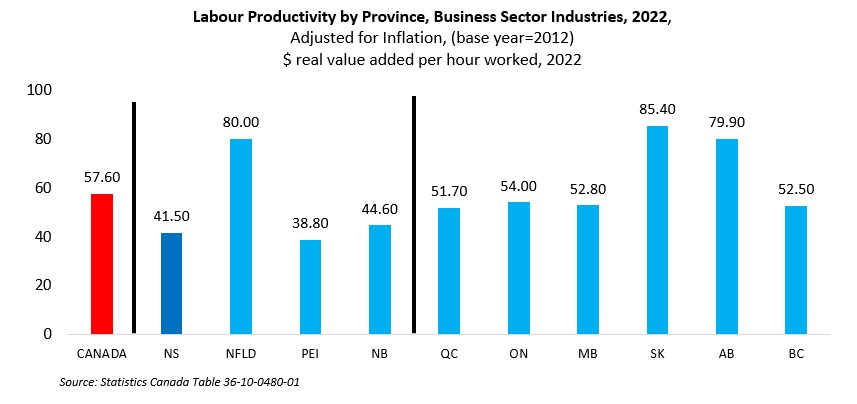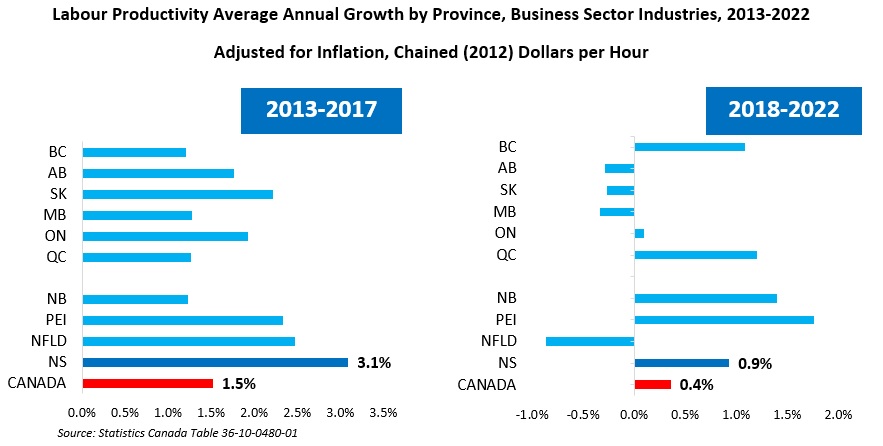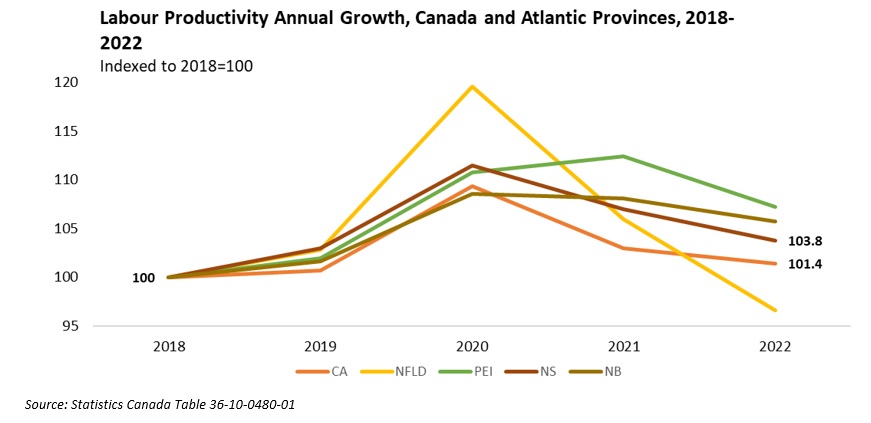Labour productivity measures the amount of goods and services produced by one hour of labour -- it captures how efficiently goods and services are produced.
Labour productivity is driven by several factors such as human capital, investment, innovation, business, and policy environments as well as other global forces. The burden of improving productivity falls on not just governments, but on individual firms and their management.
Gains in productivity can help Nova Scotia’s competitiveness in relation to other provinces and help moderate the impacts of an ageing and declining workforce in some areas of the province. Improvements in labour productivity can be influenced by both government and businesses.
The productivity figures that follow focus on business sector industries and exclude government and non-profit institutions. For example, government-funded schools are excluded from the education sector.
Provincial Comparison
Nova Scotia continued to have the second lowest labour productivity (after Prince Edward Island) among the ten provinces in 2022, at $41.50 in real value-added per hour worked. Labour productivity in Nova Scotia was lower than the national level in all industries, except for:
- Services sector: “information & cultural industries”, “finance and insurance, and holding companies”, “finance and insurance”, and “educational services.”
- Other private services: “personal services and private households”
- Non-durable manufacturing industries
Labour productivity is calculated by dividing the real value added by the estimated number of hours worked. Therefore, provinces such as Alberta, Saskatchewan, and Newfoundland and Labrador generate high amounts of real value-added due to the size of resource and/or capital-intensive industries that require comparatively fewer hours worked. These provinces tend to have high levels of labour productivity and drive up the national average.
Nova Scotia continued to have the second lowest labour productivity among the ten provinces in 2022 (it held the same ranking in 2021).

Growth
Due to resource and capital intensity differences among provinces, it is also important to look at productivity growth rates. The chart below shows that Nova Scotia had the strongest productivity growth among the provinces in the 2013-2017 period. Nova Scotia’s productivity growth between 2018 and 2022 was above the national average as well. Between 2018 and 2022, Newfoundland and Labrador had the lowest labour productivity growth, and Prince Edward Island had the highest.


Atlantic Canada experienced labour productivity growth in 2017, before declining in 2018 and rebounding in 2019.
The year 2020 witnessed a surge in labour productivity across the country. However, this can mostly be attributed to the significant loss of low-productivity jobs to multiple COVID pandemic shutdowns. Total hours worked in 2020 dropped by 11% from the year before, disproportionally impacting low-wage jobs in accommodation & food services and wholesale & retail trades. Real business sector GDP fell less than the number of hours worked, raising labour productivity.
As public health restrictions eased in 2021, the number of hours worked increased significantly across many industries without as large an increase in real GDP. This resulted in a decline in productivity in 2021 for most provinces (the exceptions being Prince Edward Island and New Brunswick, which witnessed small gains).
In 2022, there was a decrease in labour productivity in Nova Scotia compared to 2021. At the same time, total actual hours worked increased in both the goods and services producing sectors. Actual hours worked decreased in the service-producing sector among self-employed workers.